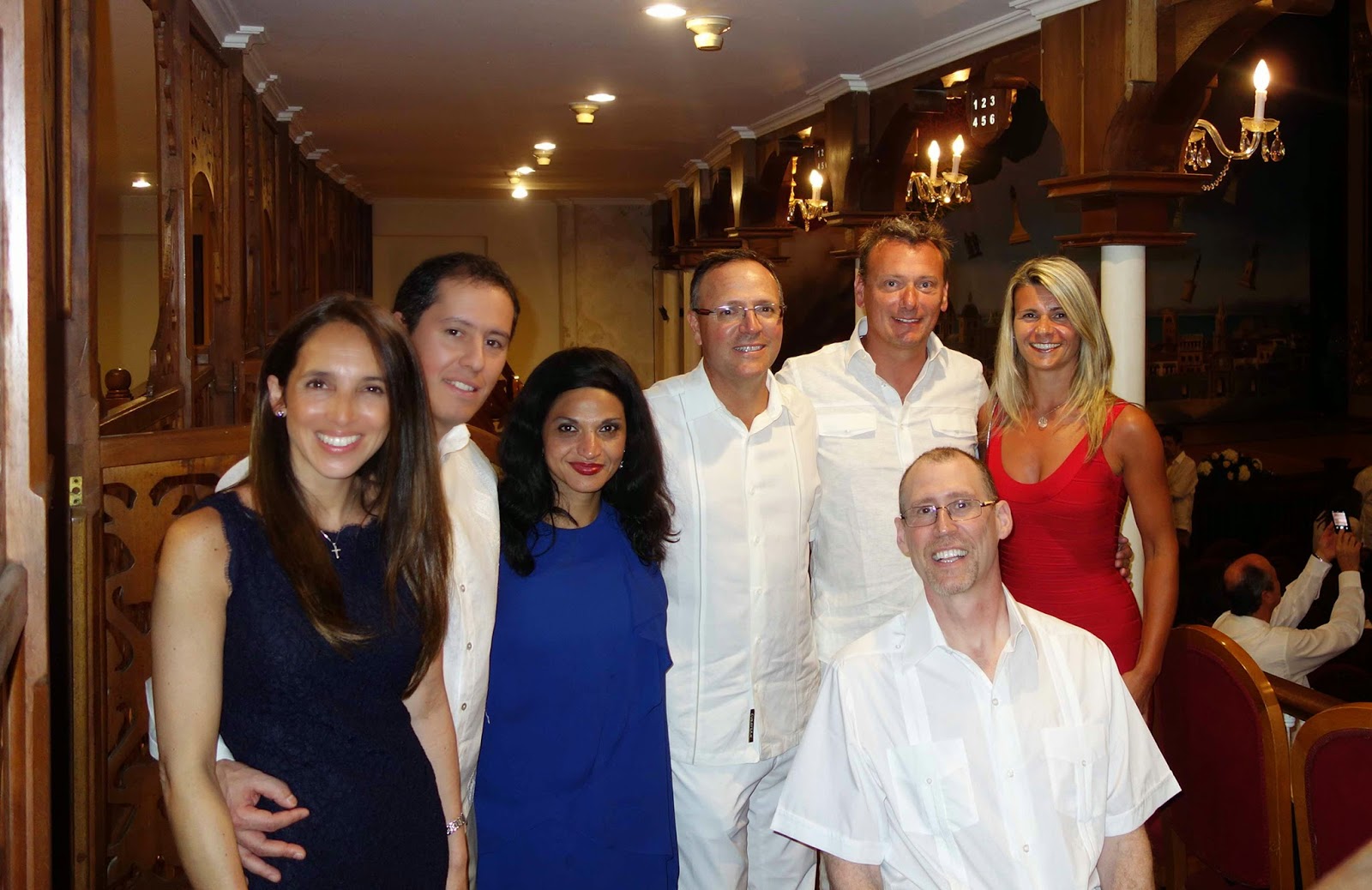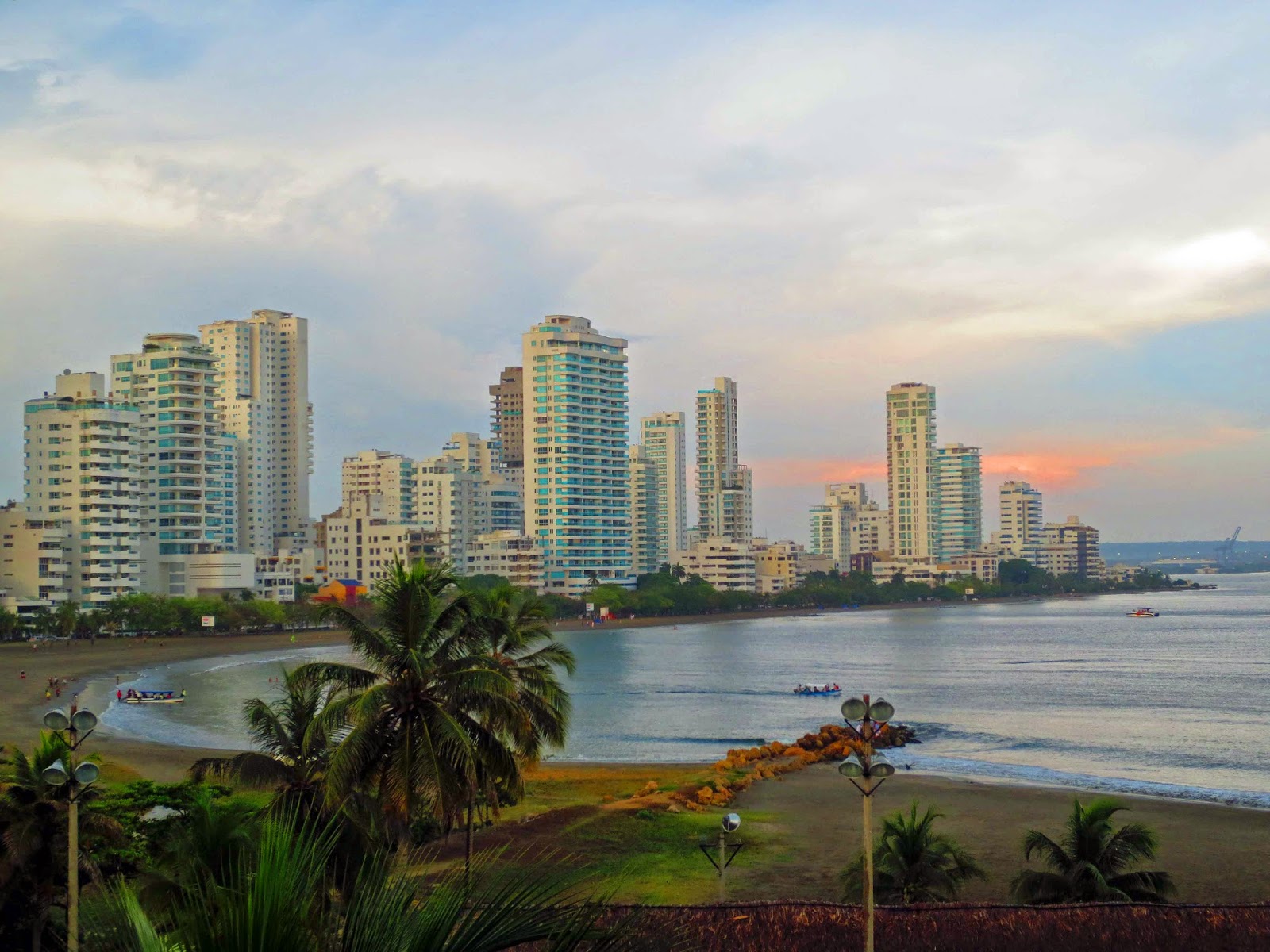Congreso Interamericano de
Radiologia (CIR), Cartagena, Columbia
At the invitation of SAR member and
Medellin native Jorge Soto, I was privileged to participate in the CIR
organized by the Columbian Association of Radiology (ACR) in the beautiful city
of Cartagena, Columbia. Happily, I was not alone, as I was in the company of
other SAR members Jorge Soto, Cooky Menias, Koenraad Mortele, and Dejana Radulovic. Even Reed
Dunnick did a cameo at the meeting as a representative of the RSNA, so the SAR
had a strong presence. The CIR is like the RSNA, except on a smaller scale and
with much, much, much better weather.
SAR travels to Columbia: Cooky, Jorge, Koenraad, and Dejana with our Chilean friends
at the President's reception.
(I'm really much taller in real life.)
Cartagena proved to be a worthy venue
with a rich history and friendly people. Smiles were abundant, even when I
butchered what little Spanish I learned from my $8 phrase book on the flight
over. I’m pretty sure the waitress at the hotel bar is still wondering why I
asked her if she had any badgers in her undergarments. I actually just wanted a
diet coke, but the two expressions sound remarkably similar in Spanish (or
maybe it’s just me). Pronunciation aside, those little travel phrase books do
really come in handy when travelling to places where English is rarely spoken
(like the Miami airport). I usually focus on the essential phrases like, “Where
can I get a beer?”, “What kind of beer do you serve?”, “May I please have
another beer?”, and “Where is the nearest bathroom…quickly?” Sometimes, the
phrase book falls short and I have to resort to sign language. After 25 minutes
of gesticulating to the AV attendant in my meeting room, I learned to turn on
the microphone. I think I also inadvertently proposed marriage, but I assume
he’ll figure out eventually that it was all an innocent mistake (but just in
case, I am looking up the phrase, “There’s nothing wrong with you, it’s me”).
See, just like Chicago in December... NOT!
I delivered 4 MRI talks at the
meeting (renal mass, pelvic floor, MRU, and pelvic mass). Translation was
provided real-time and was amazingly accurate.
The atmosphere was very relaxed but professional, and the audience
appreciative. I've discovered that the key to giving a talk with live/real-time
translation is to go slow. Not the kind of loud and slow technique used by ugly
Americans when speaking to non-english-speakers abroad. Words should be chosen
carefully to communicate as simply and efficiently as possible, avoiding
colloquialisms and slang. Humor is particularly difficult to pull off in a
translated talk, so as with this blog, I usually try to avoid it. I recommend
one slide per minute with as few abbreviations as possible. Slides should be
uncluttered and image rich, because a picture is literally worth a thousand
words when the talk is being translated.
While an image is worth a thousand
words, a dollar is worth about 1850 Columbian pesos. More than once, our small
group ran up a 7 digit dinner bill (at least I think it was in pesos). There is
no shortage of restaurants in the old city, but plan to spend the entire evening
dining, as meals start late and end much later than most North Americans are
used to. My favorite spot was a Peruvian restaurant recommended by our Chilean
colleagues called Peru Mar. The meal was nothing short of spectacular. If you
find yourself in Cartagena, be sure to also stop by the Café del Mar on the old
city walls at sunset.
The ACR President’s reception was
an amazing spectacle (unlike most SAR President’s receptions, I was actually invited
to this one). I don’t think I've ever been served dinner with 5 forks before.
After a brief etiquette coaching session from some of my more polished
colleagues, we had a spectacular meal accompanied by the usual discussion about
kidneys and the colon (can’t take us anywhere). The dinner was served on the
stage of a beautiful historic theater. I was told that the same theater had
been used for Miss Columbia pageants in the past, so as of my visit, they can
now brag that both extremes of the beauty spectrum have graced that theater. Regardless,
in my guayabera, I felt like the most interesting man in the world.
On a tour of the city, we saw some
implements of torture from the Spanish Inquisition. I took notes to send to my
friends at the ABR. It turns out that their method of divining witches was at
least as accurate as the first core exam was at identifying competent
radiologists.
We also visited the “Isla del Rosario” where SAR member Cooky
Menias joined me for an “eco” tour that included a tippy canoe ride through a
mangrove swamp (Translation was provided by our good friend and cardiothoracic
radiologist Sanjeev Bhalla). Mangrove swamps are often taken for granted but
constitute a critical part of the coastal ecosystem. They help protect coastal
areas from erosion and surging water caused by hurricanes and tsunamis. They
also facilitate deposition of sediments that contain toxins such as heavy
metals, removing them from circulation. Finally, their extensive root system
provides shelter for young aquatic organisms. Mangroves can survive in their saline environment
because their roots contain suberin, a waxy hydrophobic substance that help the
trees remove over 90% of the salt at the root level. Mangroves also survive in
a hypoxic environment that would be inhospitable to most plants through
specialized structures that sit above the water level and allow them to
“breath”. Unlike the portrayal in Life of
Pi, Mangrove forests are not carnivorous.
A trip through the mangroves in a very unstable canoe




